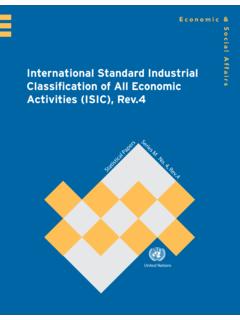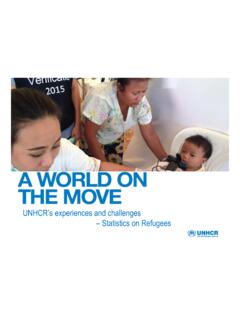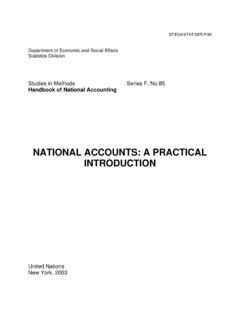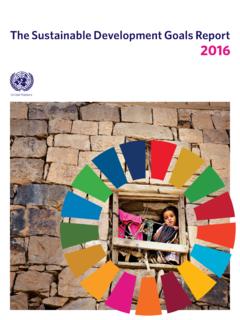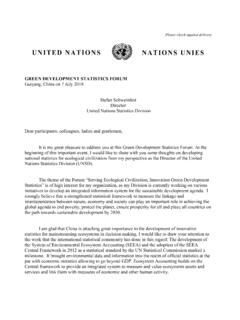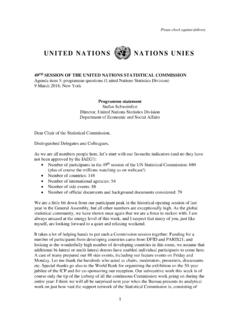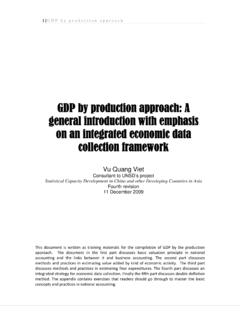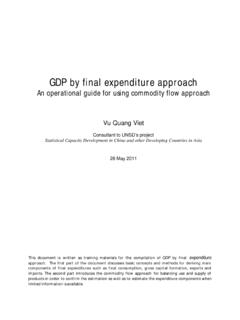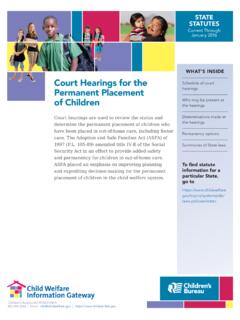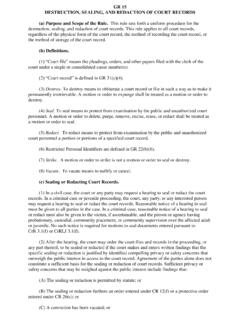Transcription of PROVISIONAL GUIDELINES ON STANDARD INTERNATIONAL …
1 ST/ESA/ DEPARTMENT OF INTERNATIONAL ECONOMIC AND SOCIAL AFFAIRS STATISTICAL OFFICE STATISTICAL PAPERS Series M PROVISIONAL GUIDELINES ON STANDARD INTERNATIONAL AGE CLASSIFICATIONS UNITED NATIONS New York, 1982 NOTE Symbols of United Nations documents are composed of capital letters combined with figures. Mention of such a symbol indicates a reference to a United Nations document. 1 ST/ESA/ 1 UNITED NATIONS PUBLICATION Sales No. ~~ 1 00400 Inquiries should be directed to: PUBLISHING SERVICE UNITED NATIONS NEW YORK, 10017 PREFACE lLhis publication sets out PROVISIONAL GUIDELINES on STANDARD INTERNATIONAL age classifications, as approved by the Statistical Commission at its twenty-first session, held in January 1981, and contains a statement of the purpose of STANDARD INTERNATIONAL age classifications, as well as recommended STANDARD INTERNATIONAL age classifications for demographic , social and related economic data.
2 !rhe PROVISIONAL GUIDELINES were developed on the basis of existing national practices (see annex) and INTERNATIONAL recommendations concerning age classification, as well as the comments and suggestions made by the members of the Statistical Commission at its twenty-first session. -iii- Chapter CONTENTS I. THE PURPOSE OF STANDARD INTERNATIONAL AGE CLASSIFICATIONS ..*.. II. RECOMMENDED STANDARD INTERNATIONAL AGE CLASSIFICATIONS FOR DEMOGRAPHIC, SOCIAL AND RELATED ECONOMIC DATA .. A. B. c. D. E. F. G. H. 1. J. K.
3 L. Fopulation .. Family formation, families and households .. Learning and educational services .. Earning activities and the inactive .. Distribution of income, consumption and accumulation .. Social security and welfare services .. Health, health services and nutrition .. Housing and its environment .. Public order and safety .. Time use .. Ieisure and culture .. Social stratification and mobility .. 15 - 19 4 20 - 21 8 22 - 24 9 25 - 26 10 27 10 28 - 29 10 30 10 31 - 32 11 33 - 35 11 36 12 37 - 38 12 39 12 Annex.
4 Existing INTERNATIONAL recommendations on age classification .. 13 Paragraphs Page 1 -4 1 5 - 39 2 -iv- I. THE PUWOSS OF STANDARD INTEEATIONAL AGE CLASSIFICATIONS 1. Age is among the most frequently collected and reported characteristics of persons in a wide variety of social, demographic and related economic statistics, and it is almost universally employed as a classification variable. Despite its wide usage as a classification variable, and its cardinality, linkage and comparison of age data are extremely difficult at both the national and INTERNATIONAL levels as a result of the lack of co-ordination among age classifications used for data from a wide variety of sources and subject areas.
5 2. Age classifications are tools for the meaningful presentation of age information, cross-tabulated by demographic, social and related economic data. They seek to provide a reasonable middle ground between the presentation of data by single years of age and the utilization of endless varieties of age classifications for different purposes. STANDARD age classifications facilitate linkage and comparability of data from different sources, over time, and within and among different subject areas. 3. While standardization and harmonization of age classifications is desirable at both the national and INTERNATIONAL levels, the PROVISIONAL GUIDELINES are geared toward the need for improved data comparability at the INTERNATIONAL level.
6 It is intended that the PROVISIONAL GUIDELINES be used to modify or complement, not to replace, existing national age classifications used for the presentation of summarized data. Wherever possible, national demographic, social and related economic data, cross-tabulated by age, should be presented, utilizing existing national age classifications to the extent that they are identical and complementing them to the extent necessary with the ones shown in chapter 11. The latter may be accomplished by substituting the recommended STANDARD INTERNATIONAL age groups for those used nationally, or by subdividing nationally used age groups in a manner which permits the reader or analyst to regroup the data in conformity with the INTERNATIONAL age classifications.
7 Beyond that, the PROVISIONAL GUIDELINES might stimulate the development of national STANDARD age classifications where none exist. 4. To avoid any possible confusion, it should be emphasized that the use of STANDARD INTERNATIONAL age classifications relates only to the presentation of data and not to their collection and storage. -l- II. RECOMMENDED STANDARD INTERNATIONAL AGE CLASSIFICATIONS F'OR D~EMOGRAFWC, SOCIAL AND RELATED ECONOMIC DATA 5. me classifications set out in this chapter were developed after careful consideration of exiting national practices and INTERNATIONAL recommendations.
8 A review of current national practices relating to age classifications L/ showed that while many countries have made efforts to standardize age classifications, many different age classifications are in use and that they vary in group size (number Of years grouped together), group boundaries (ages defining group) and age range (lowest and highest age). However, apart from the inherent differences stemming from the various national legislative and administrative policy needs and practices, several important common elements were apparent.
9 They include the widespread use of five- and ten-year age groups, with the boundaries generally beginning at multiples of five and ten and ending at four and nine. The existing INTERNATIONAL recommendations, presented in the annex exhibit similar patterns. The existence of those common elements has a positive impact on the feasibility of the design and use of STANDARD INTERNATIONAL age classifications. 6. Bearing in mind the considerable agreement in approach at the national and INTERNATIONAL levels, the following objectives were taken into consideration in developing the age classificationsr (a) To permit maximum integration of data and comparability with and among different subject areas and over time7 (b) Tb follow, as closely as possible, the existing INTERNATIONAL recommendations and national practices concerned with age classificationr (c)
10 'Lo provide and preserve as much as possible of the originally collected information in the presentation of data7 (d) W permit the identification of client groups, , subgroups of the population, which are of policy interest7 (e) 'lb minimize the impact of errors in age reporting such as age heaping, digit preference and the like. 2/ 7. Classifications were developed in 12 subject areas, for a total of 34 topics. It is hoped that the topics covered provide sufficient guidance for related topics. I/ Social and Demographic Statistics: Classification of Age ( ), United Nations, New York.

